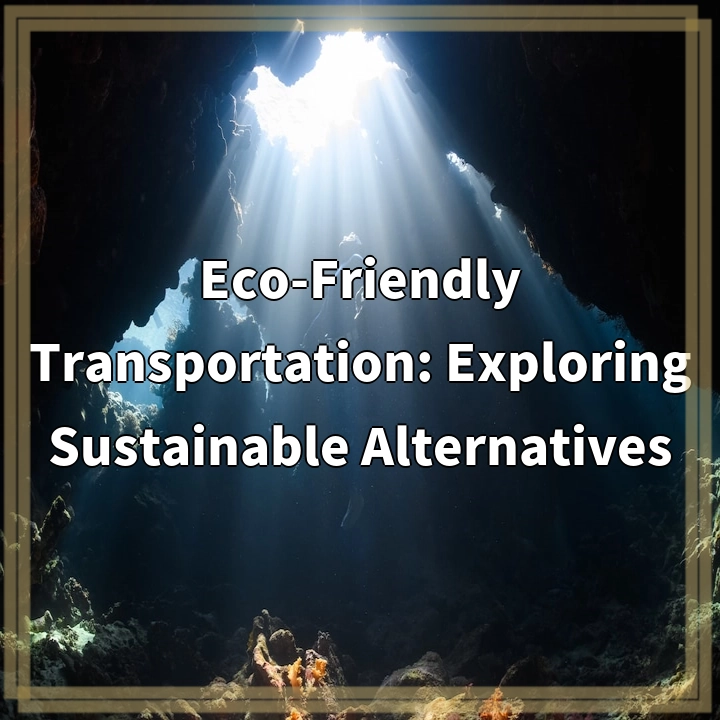
What is Eco-Friendly Transportation?
Eco-friendly transportation refers to various modes of transportation that have a minimal negative impact on the environment. These alternatives aim to reduce greenhouse gas emissions, promote energy efficiency, and minimize pollution compared to traditional modes of transportation.
Exploring the Real-World Problems
Traffic Congestion
Traffic congestion is a significant problem in many urban areas, leading to increased travel times, fuel consumption, and air pollution. As more people rely on personal vehicles, road networks become overwhelmed, worsening the environmental impact of transportation.
Air Pollution
Conventional transportation contributes to air pollution, releasing harmful pollutants such as carbon monoxide and nitrogen oxides. These pollutants not only harm human health but also contribute to climate change and the deterioration of the overall air quality.
Greenhouse Gas Emissions
The transportation sector is one of the largest contributors to greenhouse gas emissions globally. The combustion of fossil fuels, especially in cars and trucks, releases carbon dioxide and other greenhouse gases that trap heat in the atmosphere, leading to climate change and its associated environmental consequences.
Dependency on Non-Renewable Fuels
Traditional transportation heavily relies on non-renewable fossil fuels such as gasoline and diesel. The extraction, refining, and combustion of these fuels not only deplete natural resources but also contribute to global warming. Finding sustainable alternatives is crucial to reduce our reliance on these finite resources.
Lack of Infrastructure
One major challenge in adopting eco-friendly transportation alternatives is the lack of infrastructure to support their widespread use. Insufficient public transit systems, limited bike lanes, and inadequate charging stations for electric vehicles hinder the adoption of sustainable transportation methods.
Cost and Affordability
Transitioning to eco-friendly transportation can come with a higher upfront cost, making it less accessible for many individuals and communities. Electric vehicles and other sustainable alternatives often have a higher purchase price, limiting their affordability for a significant portion of the population.
Resistance to Change
Resistance to change is another challenge when it comes to adopting and embracing eco-friendly transportation practices. Despite the clear environmental benefits, many individuals and organizations are hesitant to transition away from traditional modes of transportation due to familiarity, convenience, and perceived barriers.
By understanding the real-world problems associated with eco-friendly transportation alternatives, we can work towards finding solutions that address these challenges while moving towards a more sustainable and environmentally-friendly future.

Solutions for Eco-Friendly Transportation
Promoting sustainable transportation alternatives requires a comprehensive approach addressing the real-world problems associated with traditional modes of transportation. Here are some solutions:
Invest in Public Transit
Expanding and improving public transit systems can encourage more people to leave their cars at home. By providing affordable, reliable, and efficient public transportation options, we can reduce traffic congestion and decrease the environmental impact of individual vehicle use.
Promote Active Transportation
Encouraging walking, cycling, and other forms of active transportation can significantly reduce the reliance on cars for short commuting distances. Building and improving infrastructure, such as bike lanes and pedestrian-friendly pathways, can make active transportation safer and more appealing.
Support Electric Vehicles
Transitioning to electric vehicles (EVs) can greatly reduce greenhouse gas emissions and dependence on fossil fuels. Governments and organizations can provide incentives, such as tax credits and charging station infrastructure, to accelerate the adoption of electric vehicles.
Introduce Carpooling and Ride-sharing
Encouraging carpooling and ride-sharing initiatives can help reduce the number of vehicles on the road, alleviate traffic congestion, and decrease carbon emissions. Technology-driven platforms and incentives can make these alternative transportation methods more convenient and accessible.
Improve Urban Planning
Supporting smart urban planning practices can help create walkable communities, with residential areas, businesses, and amenities in close proximity. Designing cities and neighborhoods to prioritize public transit, pedestrian-friendly spaces, and mixed-use developments can promote eco-friendly transportation options.
Increase Awareness and Education
Raising awareness about the environmental impacts of transportation and the benefits of sustainable alternatives is crucial. Educational campaigns, information resources, and outreach programs can empower individuals and communities to make informed choices and adopt eco-friendly transportation practices.
Policy Changes and Regulation
Governments can play a significant role in transforming transportation systems by implementing policies, regulations, and incentives that prioritize sustainability. This can include stricter fuel efficiency standards, support for renewable energy sources, and funding for research and innovation in eco-friendly transportation.
By implementing these solutions and fostering collaboration between various stakeholders, we can overcome the challenges and transition towards a more sustainable and eco-friendly transportation system.















